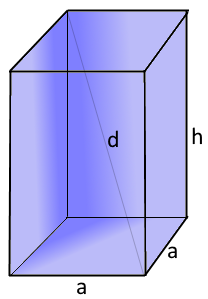Square Pillar Calculator
Online calculator and formulas for calculating a square pillar
Square Pillar Calculator
The Square Pillar
A Square Pillar is a rectangular prism with a square cross-section throughout its height.
Square Pillar Properties
The structural column: Rectangular prism with square cross-section
Square Pillar Structure

The square pillar with uniform cross-section.
Essential for structural support and architecture.
|
|
What is a Square Pillar?
A Square Pillar is a fundamental structural element:
- Definition: Rectangular prism with square base and top
- Six faces: Two square faces and four rectangular faces
- Uniform cross-section: Square throughout the height
- Vertices: 8 vertices total
- Edges: 12 edges (4 + 4 + 4)
- Applications: Structural columns, architectural elements
Geometric Properties of Square Pillars
The Square Pillar demonstrates essential structural geometry:
Basic Parameters
- Faces: 2 square, 4 rectangular
- Base: Square with side length a
- Height: Vertical dimension h
- Euler formula: V - E + F = 8 - 12 + 6 = 2
Special Properties
- Structural stability: Square base provides balance
- Load distribution: Even weight distribution
- Right angles: All faces meet at 90°
- Symmetry: Four-fold rotational symmetry
Mathematical Relationships
The Square Pillar follows simple geometric principles:
Volume Formula
Simple multiplication of square base area and height. Clean and direct.
Surface Formula
Two square bases plus four rectangular sides. Comprehensive surface coverage.
Applications of Square Pillars
Square Pillars are fundamental in numerous applications:
Architecture & Construction
- Building support columns
- Structural pillars and posts
- Bridge supports
- Foundation elements
Engineering & Manufacturing
- Machine frames and supports
- Structural beams
- Tool posts and fixtures
- Equipment pedestals
Furniture & Design
- Table and desk legs
- Bed frame supports
- Shelf supports
- Decorative columns
Education & Analysis
- Geometric teaching models
- Structural analysis examples
- Volume calculation exercises
- Engineering design studies
Square Pillar Formulas
Volume (V)
Square base area times height
Surface Area (S)
Two square bases plus four rectangular sides
Space Diagonal (d)
3D diagonal from corner to opposite corner
Base Diagonal
Diagonal across the square base
Square Pillar Parameters
Square base side
Vertical dimension
Uniform square
The square pillar maintains constant square cross-section throughout its height
Calculation Example for a Square Pillar
Given
Find: All properties of the square pillar
1. Volume Calculation
Using the volume formula:
\[V = a^2 \cdot h\] \[V = 5^2 \cdot 8\] \[V = 25 \cdot 8 = 200\]The volume is 200 cubic units
2. Surface Area Calculation
Using the surface area formula:
\[S = 2 \cdot (a^2 + 2 \cdot a \cdot h)\] \[S = 2 \cdot (25 + 2 \cdot 5 \cdot 8)\] \[S = 2 \cdot (25 + 80) = 210\]The surface area is 210 square units
3. Space Diagonal Calculation
Using the diagonal formula:
\[d = \sqrt{2 \cdot a^2 + h^2}\] \[d = \sqrt{2 \cdot 25 + 64}\] \[d = \sqrt{50 + 64} = \sqrt{114}\] \[d ≈ 10.68\]The space diagonal is approximately 10.68 units
4. Base Diagonal
Base diagonal calculation:
\[d_{base} = a\sqrt{2}\] \[d_{base} = 5\sqrt{2}\] \[d_{base} ≈ 5 \times 1.414 = 7.07\]The base diagonal is approximately 7.07 units
5. Complete Square Pillar Properties
The square pillar with optimal structural proportions
The Square Pillar: The Foundation of Architecture
The Square Pillar stands as one of the most fundamental and enduring elements in both architecture and engineering. This elegant rectangular prism, with its square cross-section, represents the perfect marriage of geometric simplicity and structural efficiency. From ancient temples to modern skyscrapers, the square pillar has served as the backbone of human construction, providing reliable vertical support while maintaining mathematical precision. Its straightforward geometry— characterized by clean lines, right angles, and uniform cross-sections—makes it both aesthetically pleasing and structurally sound, embodying the principle that the most effective solutions are often the simplest.
The Science of Structural Support
The Square Pillar demonstrates fundamental structural principles:
- Load distribution: Square base provides even weight distribution
- Compressive strength: Vertical orientation optimized for compression
- Buckling resistance: Square cross-section resists lateral buckling
- Geometric stability: Right angles provide structural rigidity
- Material efficiency: Minimal material for maximum strength
- Symmetrical loading: Four-fold symmetry distributes forces evenly
- Construction simplicity: Easy to manufacture and assemble
Architectural Excellence
Historical Significance
From Egyptian obelisks to Greek temples, square pillars have defined architectural history, proving their timeless effectiveness in monumental construction.
Mathematical Precision
The square pillar's formulas demonstrate the beauty of geometric simplicity, with clean relationships between dimensions and properties.
Modern Applications
Contemporary architecture continues to rely on square pillars for their structural integrity, cost-effectiveness, and design versatility.
Engineering Optimization
The square cross-section provides an optimal balance between material usage, structural strength, and manufacturing simplicity.
Summary
The Square Pillar represents the triumph of geometric simplicity in structural design. Its rectangular prism form, with consistent square cross-sections, provides an ideal balance of strength, stability, and material efficiency. The mathematical relationships governing its properties—from the straightforward volume calculation to the elegant surface area formula—reflect the underlying principles that make this shape so universally effective. Whether supporting the roof of an ancient temple, forming the framework of a modern building, or serving as a design element in contemporary architecture, the square pillar continues to demonstrate that sometimes the most profound engineering solutions are also the most geometrically pure. In a world of complex structures and advanced materials, the square pillar reminds us that fundamental geometric principles remain the foundation upon which all great architecture is built.
|
|
|
|
Tetrahedron • Cube • Octahedron • Dodecahedron • Icosahedron